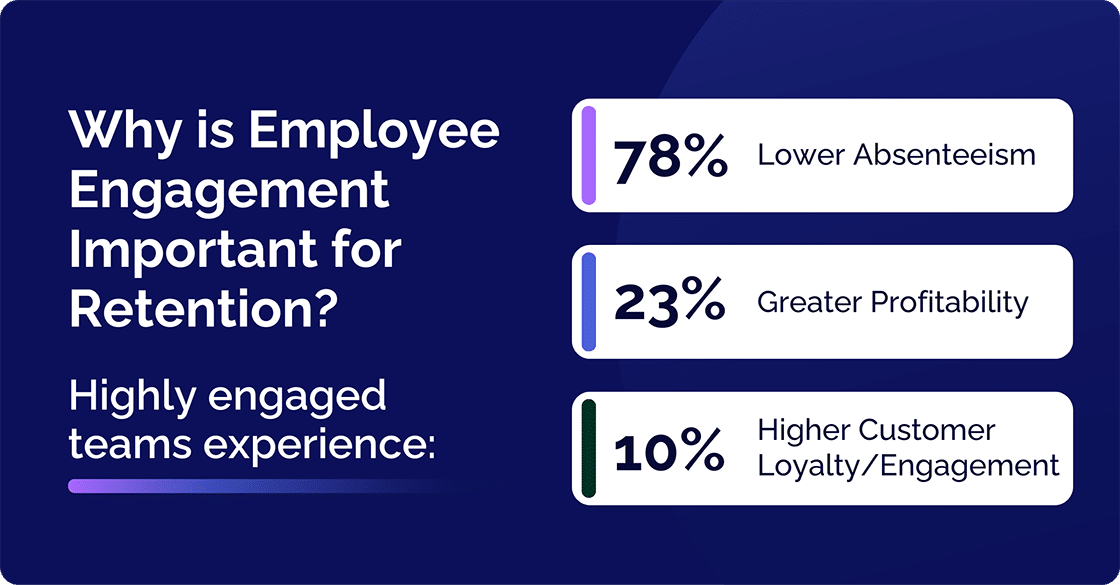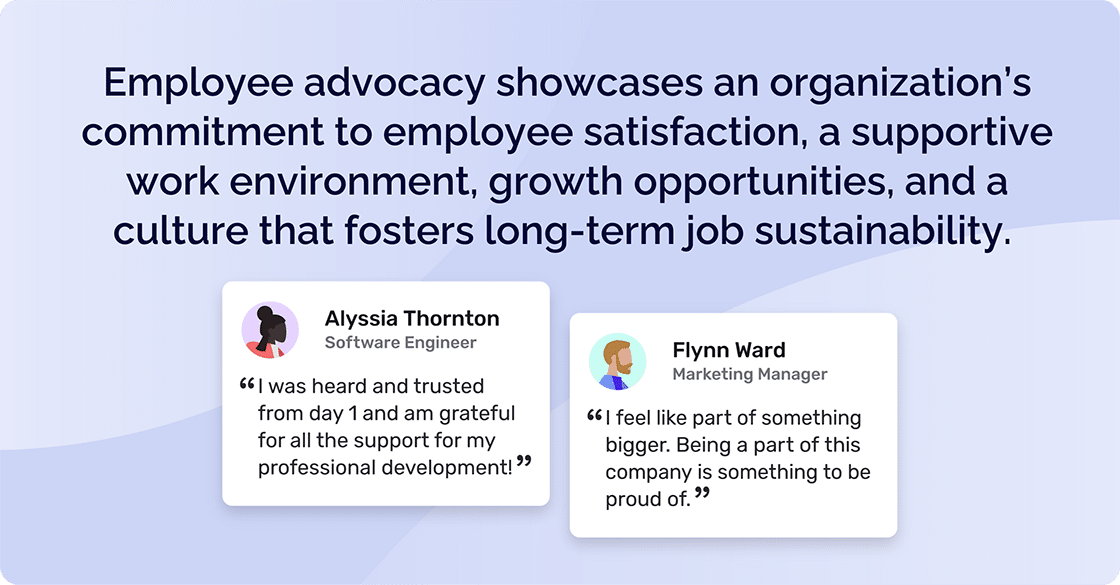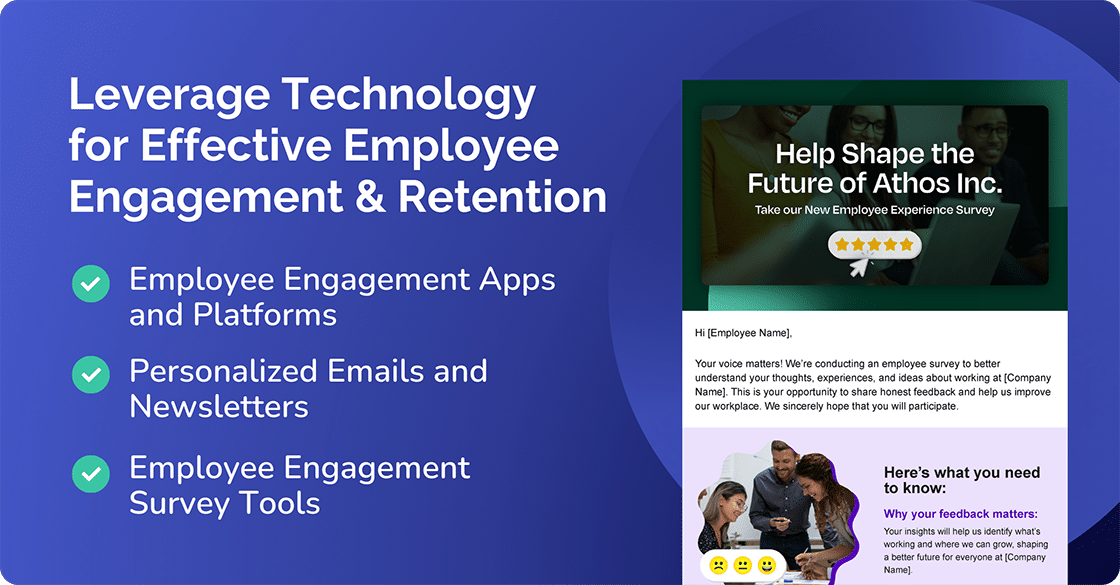Unlock the potential of your workforce with proven techniques for employee engagement and retention and maximize productivity and profitability.

.png)
It can be difficult to know what to include in an employee survey. That’s why we have created a template that you can use for FREE to ensure your employee surveys are engaging. Get the responses that will help you understand your audience.
Access NowIn today’s competitive business environment, employee engagement and retention play crucial roles in the success of organizations. When employees are engaged and committed, they are more likely to contribute their best efforts, resulting in increased productivity, higher morale, and reduced turnover rates.
One of the key components is effective internal communication. By establishing transparent communication channels, companies can ensure that their employees feel valued, connected, and motivated. However, it’s crucially important to understand the relationship between internal communication and employee engagement and retention. Internal communication done right can lead to more engaged employees, which also increases employee satisfaction. If employees are more satisfied, productivity improves, leading to overall value for the organization.
Benefits include retention of top talent and the opportunity to promote best practices for enhancing employee engagement. The organization can provide insights into measuring and evaluating employee retention and engagement efforts. And by leveraging the power of internal communication, they can foster happier employees and attain success.
Personalized and targeted communications are pivotal strategies for enhancing employee engagement, as this post, 6 Best Internal Communications Examples and Success Stories illustrates. It highlights how Cerkl Broadcast’s powerful Audience Manager and AI-powered content delivery can transform employee engagement and drive organizational success, regardless of industry niche. For example, the traffic control company, Flagger Force achieved a 58% open rate and a 68% click-through rate in little more than a year after implementing Broadcast, indicating just how much the platform had helped to increase employee engagement. The company’s goal had been a minimum of 50% open rates and a 20% click-through rate.
Once you measure existing engagement and retention levels in your organization, you can take steps to improve by upgrading and implementing proven best practices.
Well known for its ongoing top-notch research, Gallup estimates that highly engaged teams show 21% or 51% less employee turnover for high-turnover and low-turnover organizations respectively, 78% lower absenteeism, 23% greater profitability, and 10% higher customer loyalty/engagement.

“Asking, ‘Why is employee engagement important?’ is a vital question for leaders to consider. Employee engagement has many benefits; without employee engagement, there's no team engagement, making it more difficult to improve business outcomes.”
Gallup
Retaining top talent and reducing turnover is crucial for an organization’s success. High-performing employees bring valuable skills, knowledge, and experience to the table. When companies retain these individuals, they benefit from their expertise and the continuity they provide. Retention of top talent also contributes to a positive work environment, as other employees are inspired by their peers’ achievements and growth.
By retaining talented employees, organizations can maintain a high level of productivity, ensure continuity in key projects, and foster a positive work culture. Top performers often serve as role models for other employees, inspiring them to strive for excellence and contributing to the overall development of the workforce. It also saves organizations from costs associated with recruitment, onboarding, and training new employees. Ultimately, this results in increased efficiency and profitability.
Employee turnover comes with a high price tag. It involves costs from recruiting, onboarding, training, and lost productivity during the transition period. Gallup estimates that replacing leaders and managers costs around 200% of their salary, replacing employees in technical roles costs 80% of their salary, and replacing frontline workers costs 40% of their salary, excluding unmeasured losses in morale and knowledge.
Additionally, turnover negatively impacts employee morale and disrupts team dynamics. If people are constantly joining and leaving organizations, it’s impossible to establish a consistent work state. By focusing on employee retention, organizations can reduce these costs and maintain a stable and efficient workforce.
The solution, of course, is to increase engagement and reduce turnover. A Gallup Workplace post, 42% of Employee Turnover is Preventable but Often Ignored, states that “42% of employees who voluntarily left their organization in the past year report that their manager or organization could have done something to prevent them from leaving their job.”
In its State of the Global Workforce 2024 Report, Gallup shares statistics from a 2024 meta-analysis that involved 183,000 business units across 53 industries in 90 countries. They distinguish between high-turnover organizations that have more than a 40% annualized turnover and those with a low turnover below 40% annually. They found that when teams were highly engaged, turnover dropped from 21% in high-turnover organizations, and where there was low low-turnover, to 51%.
A lot goes into attracting top talent, and if there is low retention, these people might not stay long. Things like employee banding, education, and onboarding take lots of time and money. That’s why it’s so important to focus on employees who are already working for you.
Employee advocacy is a powerful tool for attracting top talent and enhancing an organization’s employer brand. Satisfied employees serve as brand ambassadors, sharing their positive experiences and thoughts about working for the company. These testimonials highlight the potential impact of effective employee engagement and retention strategies. They showcase an organization’s commitment to employee satisfaction, a supportive work environment, growth opportunities, and a culture that fosters long-term job sustainability.
By sharing their stories, employees add an authentic touch to the organization’s marketing and branding efforts, building trust and credibility with customers, clients, and potential hires. This approach not only attracts new talent but also reinforces the company’s unique strengths and values, providing valuable insights into its culture and work environment.

Employee quotes also add an authentic and personal touch to the organization’s marketing and branding efforts. They showcase the company’s commitment to employee satisfaction and can enhance its reputation as a desirable workplace. When employees share their positive experiences and thoughts about working for the company, it creates a sense of trust and credibility among customers, clients, and potential hires.
Employee engagement and retention are crucial for improving productivity and performance. When employees are engaged, they are more motivated, focused, and committed to their work. This leads to increased job satisfaction, better work quality, and higher levels of productivity. Engaged employees are also more likely to take ownership of their work, innovate, and adapt to changes, ultimately driving business results. By prioritizing engagement and retention, organizations can reap the benefits of a more productive and high-performing workforce.
Fostering a positive work environment characterized by open communication, trust, and respect among colleagues and leaders is crucial. It is a place where employees feel valued, heard, and supported, and where they can grow and develop their skills. A positive work environment also promotes collaboration, innovation, and creativity, leading to a more engaged and motivated workforce. By creating a positive work environment, organizations can reduce turnover, improve morale, and increase job satisfaction, ultimately driving business success.
Craft effective surveys to measure employee sentiment and boost engagement
.png)
A much-quoted piece of advice from Richard Branson, founder of the Virgin Group, highlights the potential simplicity of a good employee engagement and retention strategy.
“Take care of your employees, and they’ll take care of your business.”
Richard Branson
But it does take planning and a lot of positive input from leaders and managers. Here are four of the most important best practices to follow.
A positive and inclusive work environment promotes engagement and encourages employees to stay with the organization. Inclusivity means embracing diversity in all its forms, including race, gender, age, ethnicity, religion, sexual orientation, and disabilities. It’s crucial for fostering employee satisfaction, collaboration, and organizational success. There are many ways to create and foster this kind of environment within internal communication.
Begin by establishing clear policies and practices that promote equal opportunities and fair treatment for all employees. By embracing diversity and inclusion, organizations create a sense of belonging and respect among employees. This fosters innovation, collaboration, and employee satisfaction, leading to higher retention rates.

Promoting collaboration and teamwork creates a supportive environment where employees feel valued and motivated. By fostering cross-functional collaboration, organizations can tap into the diverse expertise of their workforce and enhance engagement and retention. Encouraging open communication and active listening allows for the expression of diverse perspectives and experiences, which cultivates a sense of belonging and psychological safety.
Employees value growth and development opportunities. Organizations should invest in training and development programs that help employees acquire new skills and advance in their careers. This way, employees have more cultural and social competency. This can help them in new situations and make them more adaptable.
Provide avenues for professional growth, such as training programs, mentorship, and internal mobility. Create individual development plans for employees and support their ongoing learning and skills development. Establish clear career paths and communicate opportunities for advancement to motivate employees to stay and grow within the organization.
Comprehensive training and development programs enable employees to enhance their skills, stay relevant, and pursue growth within the organization. These programs can include workshops, mentoring, job rotations, and tuition reimbursement initiatives. Moreover, these programs contribute to building diverse and inclusive teams, enhancing creativity, innovation, and overall organizational performance.
If you want more people in your organization to learn about internal communication, then it might be valuable to attend a conference dedicated to the topic. This encourages continuous learning and will develop communication skills they can bring back to work.
Career pathing and succession planning demonstrate an organization’s commitment to employee growth and development. As a result, organizations help employees visualize their future within the company, motivating them to stay and contribute their best efforts.
Recognizing and rewarding employee contributions is crucial for boosting engagement and retention. This recognition boosts employee morale and motivation, leading to increased job satisfaction and engagement. When employees feel valued and recognized, they are more likely to go above and beyond in their work, resulting in improved productivity and performance. Additionally, recognition and rewards programs contribute to employee retention by creating a sense of loyalty and commitment to the organization.
Employees who feel appreciated are less likely to seek opportunities elsewhere. Moreover, these programs help to reinforce desired behaviors and values, aligning employee actions with organizational goals. By publicly acknowledging exceptional performance or milestones, recognition programs also inspire healthy competition and inspire others to strive for excellence.
Some of the most popular topics for hospital employee newsletters are wins and team members. Material about recognizing and rewarding employees is not only a great way to make employees feel valued and appreciated, but also to increase engagement.
Ensure employees are compensated fairly and receive competitive benefits packages. Conduct market research to stay updated on industry standards and make necessary adjustments to salary scales, bonuses, and other incentives. Offer benefits that cater to employees’ needs and preferences, such as health insurance, retirement plans, and flexible work arrangements.
Implement recognition programs to acknowledge and reward employees for their contributions and achievements. Recognition is closely aligned with employee engagement and promotes teamwork. Celebrate milestones, both personal and professional, and publicly recognize outstanding performance in your internal communications. Consider a mix of formal and informal recognition initiatives to ensure all employees feel valued and appreciated. Additionally, celebrating and recognizing achievements and contributions from diverse individuals and groups reinforces the importance of employee engagement and retention and creates a positive atmosphere.
Employee engagement statistics depend largely on the support of managers and how companies treat their employees.
It makes sense to invest in leadership development programs to create supportive and empowering managers who encourage engagement and retention. Train leaders to communicate effectively, provide feedback, and cultivate a positive work environment. Encourage managers to build strong relationships with their team members and support their growth and development.
Craft effective surveys to measure employee sentiment and boost engagement
.png)
Statistics on employee engagement and retention reinforce the importance of effective internal communication. These numbers emphasize the positive impact of internal communication on retention as well as overall organizational performance.
We dug out a few interesting employee retention and engagement statistics.
Jim Harter, Chief Scientist of Workplace Management and Wellbeing at Gallup, wrote in January 2025 that employee engagement in the U.S. fell to its lowest level in a decade in 2024, with only 31% of employees engaged. U.S. Employee Engagement Sinks to 10-Year Low identifies three key trends that led to reduced employee engagement in 2024:
Gallagher’s State of the Sector 2023/24 report indicated that 32% of companies thought that employee disengagement was one of the biggest barriers to success in 2024. In its Employee Communications Report 2025, Gallagher highlights how “daily hardships” can heighten disengagement and result in strained retention. This, of course, directly affects engagement. Their statistics show that only 71% of respondents regularly monitor employee engagement rates, even though 92% of them have some accountability for engagement. Also, 56% said they were accountable for employee retention, but only 40% said they were tracking the metric.
It’s vital to have a plan of action. Here are some strategies to get you going.
Organizations should identify the key drivers that impact employee engagement and retention. These may include factors like leadership effectiveness, career growth opportunities, recognition programs, and work environment. By focusing on these, organizations can use resources and implement targeted strategies to improve engagement and retention.
For instance, nurses experience burnout for many reasons. These include feeling undervalued, poor work-life balance, no sense of belonging, and low engagement with work. However, they can use this information to identify issues and find ways to increase employee retention and engagement rates.
An employee retention plan outlines the strategies and initiatives that an organization can implement to retain its workforce. It serves as a roadmap for driving employee engagement and satisfaction, ultimately leading to higher retention rates.
Internal communication is a large part of retaining a workforce and creating a strategic communication plan can be a part of your overall employee retention plan.
An employee retention plan template provides a structured framework for organizations to identify retention goals, assess current practices, and outline specific actions and timelines. The plan should address key drivers of engagement and retention, such as career development opportunities, competitive compensation and benefits, and work-life balance initiatives.
Motivated and well-supported employees are more likely to stay with an organization. Employers should prioritize nurturing motivation and well-being through various initiatives. This goes beyond physical health. It encompasses mental, emotional, and social aspects as well. When employees feel supported and cared for, they are more likely to demonstrate higher levels of creativity, innovation, and loyalty to the organization. Moreover, a strong emphasis on employee well-being contributes to a positive work-life balance, reducing stress and burnout and improving overall job performance.

It might seem like conveying values starts during the first couple of days in the office. But it really starts from the moment organizations interview and onboard new employees. Show how you are adopting those visions from the start of your interactions. Don’t just say what the ideas are. Show prospective and new employees how you adopt them into communications and culture from the start. It is much easier to teach and reiterate values than to introduce them later.
Internal communication channels should effectively convey the organization’s vision, mission, and values. Employees need to understand how their work contributes to the larger purpose and goals of the company. Regularly communicating the organization’s strategic direction helps employees align their efforts and feel a sense of purpose, increasing their commitment to staying with a company.
By consistently sharing and reinforcing these values, organizations can foster a sense of purpose, alignment, and shared identity among their workforce. Providing real-life examples and success stories that align with these values can help employees understand how they translate into action and impact the organization’s overall mission. Additionally, leaders can actively engage in open and transparent dialogues, encouraging employees to express their thoughts, concerns, and suggestions. This two-way communication promotes a sense of inclusion and belonging and allows for feedback and discussions that can further refine and strengthen organizational values.
Regular feedback and recognition are closely aligned with employee engagement and promote teamwork. Managers should provide constructive feedback to help employees grow and improve in their roles. Recognizing employee contributions, whether through public praise, rewards, or promotions, demonstrates appreciation and motivates them to continue performing at their best. Some communications can include a recognition section or shoutouts for team/individual accomplishments.
Two-way communication channels like employee surveys, suggestion boxes, and open forums, allow employees to share their ideas, concerns, and suggestions. By actively listening to employee feedback and acting on it, organizations demonstrate their commitment to creating a supportive and inclusive work environment. This fosters a sense of ownership and engagement among employees, ultimately contributing to their retention and engagement.
Technology plays a vital role in facilitating internal communication and boosting employee engagement. If employees aren’t given the right tools, they won’t be able to properly engage with coworkers and the company as a whole.
Employee communication apps and platforms provide a centralized hub for communication, collaboration, and recognition. These tools offer features such as real-time updates, past information, and personalized news feeds. This enables employees to connect and engage irrespective of their physical location. By leveraging technology, organizations can overcome communication barriers and cultivate a sense of belonging among remote and distributed teams. It can also increase employee engagement within the apps by allowing them to interact with more information and messaging.
Employee engagement platforms can also help with engaging remote employees. It might be hard to set expectations with people when you’re not face-to-face. However, it can be achieved by embracing a platform that enables you to send employees personalized communications they care about. If they are receiving relevant, important information, then they will interact with the messages they are receiving — and you will have more engaged employees.
Personalized emails and newsletters make internal communication more engaging and relevant by delivering content tailored to each employee’s role, location, interests, or team. Rather than overwhelming employees with generic updates, personalization ensures they receive only the information that’s timely, useful, and aligned with their work.
With tools like Cerkl Broadcast’s Email Blasts and News Digests, you can automate and customize messaging at scale. This will ensure that every employee receives information that matters most to them.
Employee engagement surveys are valuable tools for measuring and improving engagement levels within an organization. They assess employees’ perceptions of various aspects, such as leadership, communication, and job satisfaction. You can incorporate this in messages to get feedback about different events, projects, or procedures. By utilizing specialized tools, you can collect, measure, and analyze data effectively. You can also identify areas of improvement and take necessary actions to enhance employee engagement and retention.
Communication and follow-up actions are vital in the survey process. Inform employees about the purpose of a survey, its timeline, and how you will utilize its results.
To gauge the effectiveness of employee retention and engagement initiatives, organizations should measure key metrics. This is possible with an analytics dashboard that includes metrics like click rates, open rates, content stats, and more. All the data is easily accessible and in one place, making it easy to measure the success of communications.

Key engagement survey metrics include:
These are the metrics for measuring employee retention:
Cerkl Broadcast is more than a communication tool. It is a powerful platform designed to strengthen employee engagement and retention. With features like MyNews and News Digest, organizations can deliver personalized content that keeps employees informed, connected, and aligned with company goals.
MyNews provides real-time engagement insights and alerts, helping internal comms teams quickly identify when employees are disengaging. By using smart analytics and behavior-driven personalization, you can ensure the right messages reach the right people at the right time. News Digest is powered by automated software that curates and sends a personalized wrap-up of news to each employee.
This targeted, responsive approach not only increases awareness and alignment but also builds a stronger employee experience that motivates, supports, and ultimately helps retain your top performers.
All of this will help your organization retain high-performing employees.
We’ve talked a lot about employee engagement and how it keeps your staff on board. However, we realize how challenging it can be to evaluate employee engagement in real time.
That’s why we’ve devised a cutting-edge employee engagement survey that will enable you to do this quickly and effectively. Don’t miss this free opportunity. You’ll find it’s a great way to start improving your internal communication strategy.
.png)
Craft effective surveys to measure employee sentiment and boost engagement
What is employee retention and engagement? Employee retention refers to the ability of a company to retain its employees over a specified period of time. Employee engagement signifies the emotional commitment and involvement employees have toward their work, influencing their productivity, loyalty, and overall contribution to the organization.
How are motivation and engagement related to employee retention When employees are motivated and engaged they are more likely to stay with a company. They will also contribute their skills and energy because they feel connected to their work and the goals of the organization. Therefore, positive employee engagement generally maximizes employee retention and minimizes staff turnover.
How to improve employee engagement and retention Create a culture where employees feel valued, supported, and informed. Offer growth opportunities, clear communication, recognition, fair pay, and a healthy work-life balance. Also ensure communication is clear and offer competitive compensation, at the same time supporting a good work-life balance that minimizes stress.
What are the key factors that contribute to employee engagement and retention? The key factors contributing to employee engagement and retention include a positive culture, growth opportunities, recognition, fair compensation, open communication, strong leadership, and support for work-life balance. Effective leadership that supports and values its employees is also important.

Craft effective surveys to measure employee sentiment and boost engagement